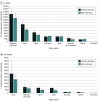Projected Lifetime Cancer Risks From Current Computed Tomography Imaging
- PMID: 40227719
- PMCID: PMC11997853
- DOI: 10.1001/jamainternmed.2025.0505
Projected Lifetime Cancer Risks From Current Computed Tomography Imaging
Erratum in
-
Errors in Figure 1.JAMA Intern Med. 2025 Jun 1;185(6):747. doi: 10.1001/jamainternmed.2025.2355. JAMA Intern Med. 2025. PMID: 40455431 Free PMC article. No abstract available.
Abstract
Importance: Approximately 93 million computed tomography (CT) examinations are performed on 62 million patients annually in the United States, and ionizing radiation from CT is a known carcinogen.
Objective: To project the number of future lifetime cancers in the US population associated with CT imaging in 2023.
Design, setting, and participants: This risk model used a multicenter sample of CT examinations prospectively assembled between January 2018 and December 2020 from the University of California San Francisco International CT Dose Registry. Data analysis was conducted from October 2023 to October 2024.
Main outcomes and measures: Distributions of CT examinations and associated organ-specific radiation doses were estimated by patient age, sex, and CT category and scaled to the US population based on the number of examinations in 2023, quantified by the IMV national survey. Lifetime radiation-induced cancer incidence and 90% uncertainty limits (UL) were estimated by age, sex, and CT category using National Cancer Institute software based on the National Research Council's Biological Effects of Ionizing Radiation VII models and projected to the US population using scaled examination counts.
Results: An estimated 61 510 000 patients underwent 93 000 000 CT examinations in 2023, including 2 570 000 (4.2%) children, 58 940 000 (95.8%) adults, 32 600 000 (53.0%) female patients, and 28 910 000 (47.0%) male patients. Approximately 103 000 (90% UL, 96 400-109 500) radiation-induced cancers were projected to result from these examinations. Estimated radiation-induced cancer risks were higher in children and adolescents, yet higher CT utilization in adults accounted for most (93 000; 90% UL, 86 900-99 600 [91%]) radiation-induced cancers. The most common cancers were lung cancer (22 400 cases; 90% UL, 20 200-25 000 cases), colon cancer (8700 cases; 90% UL, 7800-9700 cases), leukemia (7900 cases; 90% UL, 6700-9500 cases), and bladder cancer (7100 cases, 90% UL, 6000-8500 cases) overall, while in female patients, breast was second most common (5700 cases; 90% UL, 5000-6500 cases). The largest number of cancers was projected to result from abdomen and pelvis CT in adults, reflecting 37 500 of 103 000 cancers (37%) and 30 million of 93 million CT examinations (32%), followed by chest CT (21 500 cancers [21%]; 20 million examinations [21%]). Estimates remained large over a variety of sensitivity analyses, which resulted in a range of 80 000 to 127 000 projected cancers across analyses.
Conclusions and relevance: This study found that at current utilization and radiation dose levels, CT examinations in 2023 were projected to result in approximately 103 000 future cancers over the course of the lifetime of exposed patients. If current practices persist, CT-associated cancer could eventually account for 5% of all new cancer diagnoses annually.
Conflict of interest statement
Figures



Comment on
-
Balancing Computed Tomography's Benefits With Radiation Risks.JAMA Intern Med. 2025 Jun 1;185(6):719. doi: 10.1001/jamainternmed.2025.0514. JAMA Intern Med. 2025. PMID: 40227674 No abstract available.
References
-
- IMV. 2023 CT market outlook report. Accessed March 10, 2025. https://imvinfo.com/product/2023-ct-market-outlook-report/

